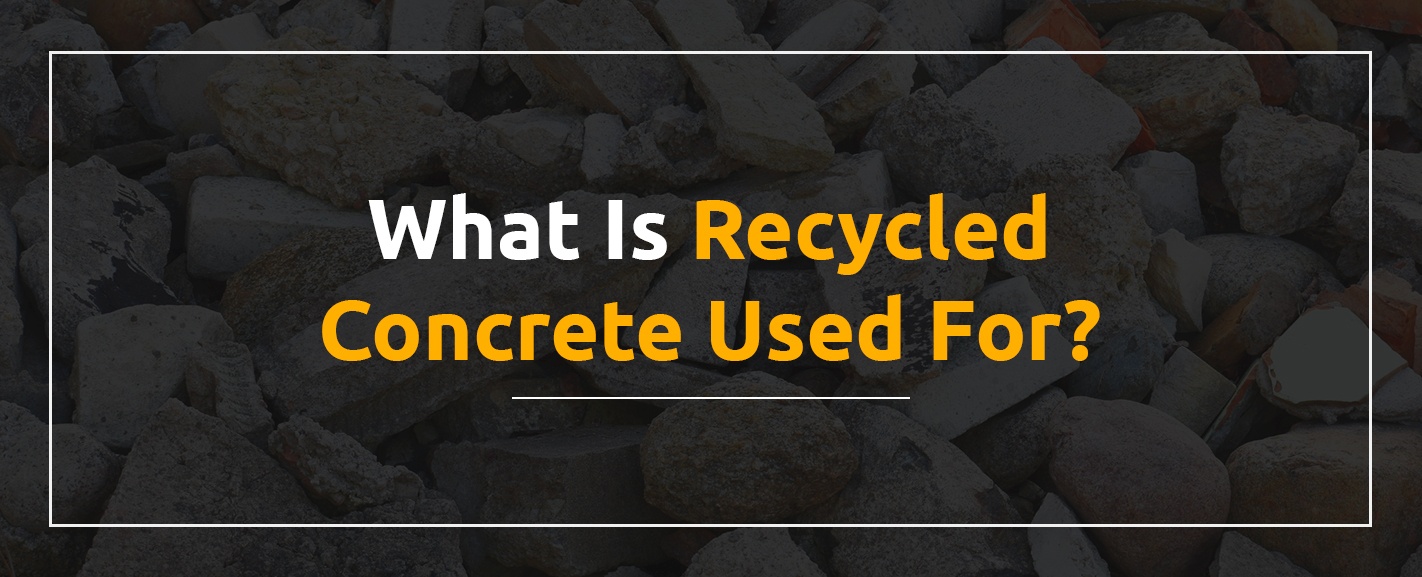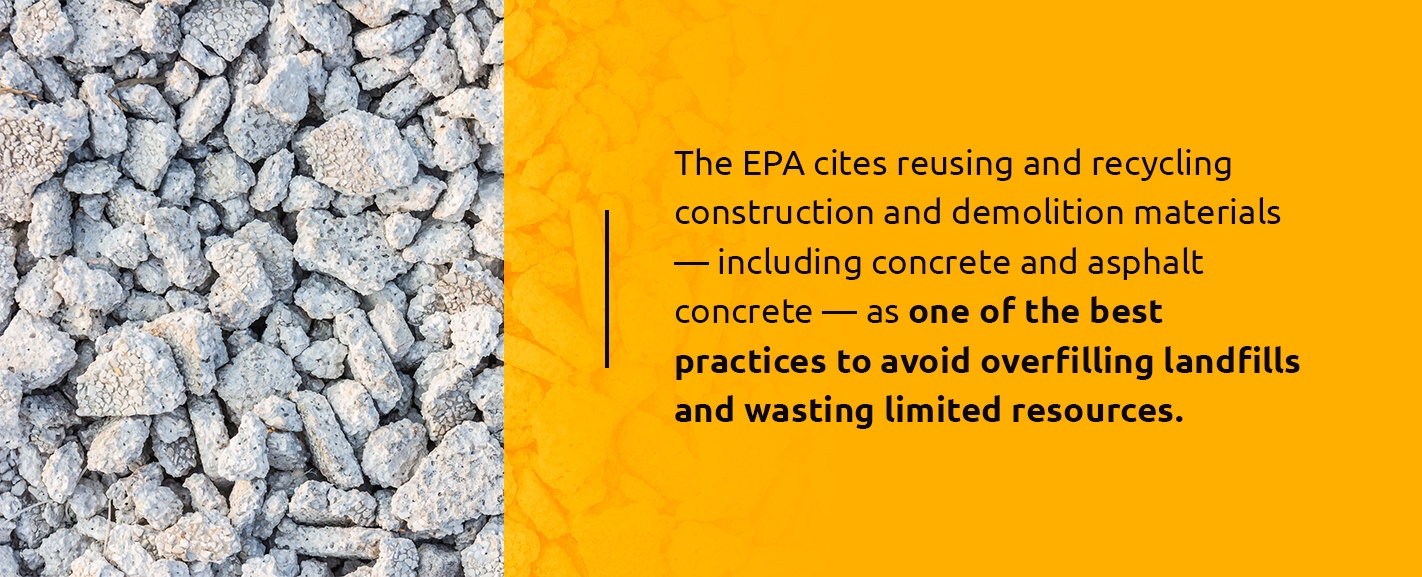
What Is Recycled Concrete Used For?
Posted By:Dynamic Concrete Pumping , Date: Feb 17, 2020

If you have never considered using recycled concrete at your worksite, you could be missing out. Recycled concrete has numerous economic and environmental benefits, and can be used in many commercial, industrial and residential applications.
What Is Recycled Concrete?
Recycled concrete is a concrete aggregate manufactured using preexisting concrete from demolished structures, sidewalks and roadways. Recycled aggregate is used as an alternative to sending used, non-biodegradable concrete to landfills.
Why Use Recycled Concrete?
The most significant benefits of using recycled concrete are economical and environmental.
The Economic Benefits of Recycled Concrete
When you use recycled concrete aggregate, you save the money it would have cost to secure, process and transport all-new material. These savings drastically increase if you use recycled concrete to rebuild or repair at the same location it was demolished. Because recycled concrete is more lightweight than virgin concrete, it has a higher yield, which results in less money spent on building costs and materials. When you choose recycled aggregate, you also save yourself the cost and potential headache of meeting proper concrete disposal regulations and locating a concrete disposal facility.
On a larger scale, the process of recycling concrete can generate several new jobs, which puts money back into your local economy.
The Environmental Benefits of Recycled Concrete
When concrete is not recycled or reused, it is sent to a landfill. The Environmental Protection Agency (EPA) estimates that in 2017, 569 million tons of construction and demolition materials were generated in the U.S. alone. Since concrete is not biodegradable, it will not break down over time. The EPA cites reusing and recycling construction and demolition materials — including concrete and asphalt concrete — as one of the best practices to avoid overfilling landfills and wasting limited resources. By eliminating the need to transport and process new materials, energy waste and harmful gas emissions from vehicles are also minimized.
Finally, the concrete recycling process can also incorporate and use other environmentally friendly practices and construction materials, including the use of old tires, scrap materials and organic waste as fuel for cement processing.
The Concrete Recycling Process
One might think that because recycled aggregate is so beneficial to builders, site managers and the environment, that it would be challenging to produce — but the concrete recycling process is relatively straightforward.
- Harvesting: First, concrete rubble is harvested from demolished buildings, sidewalks, curbs, gutters, roads, interstates, highways, airport runways, foundations and more. After the rubble is harvested, the rest of the process is either done on-site, off-site or at a concrete recycling facility.
- Crushing: Once the concrete is harvested, it is crushed using one of several crushing methods. Popular methods for crushing include portable, mobile or stationary jaw crushers, impact crushers or cone crushers. Jaw crushers and impact crushers can both be used for initial crushing. Sometimes, a secondary crushing process — usually done with a cone crusher — is required to further size the rubble.
- Screening: Because concrete aggregate is often mixed with other materials — like clay, plastic, dirt, asphalt pavement, metal and wood chips — it needs to be screened using scalping and deck screeners to be separated from those materials. Recycled concrete often goes through several screening processes, depending on the source of the concrete and how the end product will be used.
- Cleaning: The final step in the concrete recycling process is cleaning. Before concrete can be recycled into new concrete, any remaining residue from removed materials must be cleaned away. This is done through hand-picking, magnetic separation or air or water separators.
What Is Recycled Concrete Used For?
Crushed concrete is used for a variety of residential and commercial projects, including almost any building project that calls for concrete, concrete asphalt or aggregate. Some industrial, commercial and residential applications for recycled concrete include:
- Landscaping: Recycled concrete can be used for residential and commercial landscaping projects, including in the construction of retaining walls, raised flower and garden beds, to build yard drainage systems and sized down as decorative gravel.
- Construction: Use recycled aggregate or gravel made from recycled concrete for engineered structural fill and embankments, as well as a sub-base material for foundations, parking lots and driveways.
- Roadways: The U.S. Department of Transportation Federal Highway Administration uses recycled concrete whenever possible to repair, reconstruct and maintain the National Highway System, which includes more than 160,000 miles of paved roadways and more than 128,000 structures. These same processes can be used for local and small scale roadways as well.
- Development: Recycled concrete has been successfully used in several types of industrial, warehouse and office development projects, including as part of the foundation and standing structures.
- Community: Public sidewalks, walkways and asphalt pavement courts can be made out of recycled concrete and are typically just as durable and long-lasting as virgin concrete.
- Environment: The production of recycled concrete is better for the environment, and it can actually be used for environmental restoration projects. For example, in 2013, an artificial coral reef was constructed off the coast of Jacksonville, Florida, using recycled concrete taken from a local airport and contracting company. The airport and contracting company provided pieces of concrete from old culvert pipes, footer pieces, box junctions and other miscellaneous pieces. These pieces were used to construct an artificial coral reef and were laid out in a way that fish could easily use them as protection from predators and to provide a home for a diverse community of marine life.
Learn More About Recycled Concrete
At Dynamic Concrete Pumping, we are dedicated to providing you with high-quality concrete pumping services with minimal environmental impact. That’s why we offer a green alternative to waste dumping. Instead of carelessly discharging wastewater into the environment, we use a combination of equipment to separate water from cement. Additionally, we break leftover slurry down into a 100% reusable material, which saves both time and the environment.
Want to learn more about recycled concrete or discuss how it can be used in your current building project? Call us toll-free at 1-877-236-9511 or contact us online.



